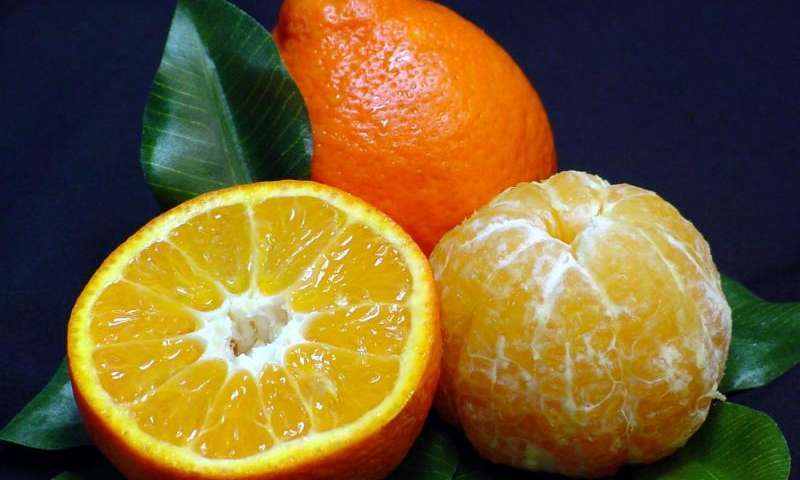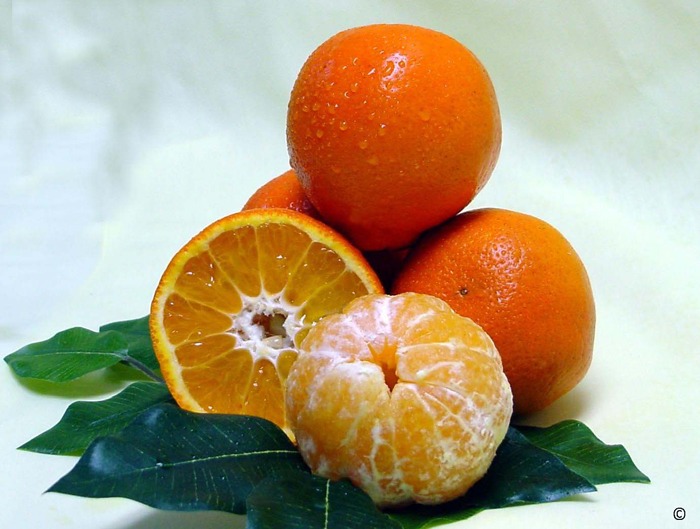Delicious Sugar Belle Mandarins Are Highly Resistant to Greening Disease!
Sugar Belle® 'LB8-9'
U.S. Patent PP 21,356
Citrus reticulata
'Sugar Belle' is a newly patented mandarin orange hybrid developed by researchers at the University of Florida. First discovered in 1985, it is not a gmo variety.
A cross between the sweet Clementine and the bell-shaped Honeybelle (aka Minneola tangelo), Sugar Belle is a rich tasting, robust fusion of sweet-tart flavor sensations. It is sweet, juicy and easy to peel.
Its bell-shaped fruit is a rich, bright orange, darker both inside and out, and contains 40% more vitamin C than the Minneola. Flavor is sweeter than the Minneola, but with more acid, and more tang. It's flavor has been described by some as "deep and complex" and "off the charts for sweetness and flavor". It is also quite aromatic.
Fruit begins to ripen in early November, about 4-6 weeks sooner than the earliest Minneolas, and approximately 6-8 weeks sooner than the highly favored Ponkan tangerines. Ripening period ranges from Nov-Jan.

Sugar Belles have a 'top knot' like the Honeybelles, though they are a tad smaller.
A hybrid of a hybrid:
Sugar Belle is a cross between a Clementine (Citrus reticulata 'Clementine') and a Minneola tangelo (Citrus reticulata 'Minneola').
Minneola tangelo is a hybrid of a Dancy tangerine (mandarin) and a Duncan Sweet grapefruit. Minneola, aka Honeybelles, were released in 1931 by the USDA.
Additional reading:
http://citruspages.free.fr/mandarins.html
http://citruspages.free.fr/mandarinhybrids.html#tanclem
Very Hardy Trees: More Resistant to Greening
In field observations since the 2006 onset of the greening crisis, UF scientists have observed that the Sugar Belle is less affected by citrus greening than other mandarines. Researchers at UF/IFAS Citrus Research and Education Center in Lake Alfred, Fl are conducting multiple studies to understand the mechanisms behind the tolerance to greening.
Sugar Belle mandarins are found to contain certain cellular activity known as metabolites that may explain it's resiliance. Scientists at UF/IFAS isolated several volatiles and beneficial compounds known as phenolics. They tested both volatile and non-volatile metabolites of the greenhouse-grown specimens.

Sugar Belle citrus cultivar. UF/IFAS File Photo.
One interesting trait of volatile metabolites is that they emit odors, while non-volatile metabolites do not.
The high levels of antimicrobial volatiles phenolic compounds may explain why Sugar Belle is more tolerant to HLB (citrus greening), but much more study is needed to understand why or how.
Sugar Belle is also highly resistant to the alternaria fungi, a problem for the Minneola for years.
Rootstocks May Also Affect Greening Tolerance
New findings from an IFAS study of Sugar Belles on various rootstocks suggests that rootstock selection may influence the trees' production, should they become infected with greening disease. “We deliberately focused the study on Sugar Belle® trees that used three of the most popular rootstocks – Swingle citrumelo, Carrizo citrange and UF-15,” Killiny said.
Sugar Belle® trees with Swingle citrumelo rootstock produced the greatest amounts of two compounds known to have antimicrobial effects, quinic acid and ferulic acid. Consequently, it appears likely that Sugar Belle® will tolerate HLB best when grown on Swingle citrumelo, because the two acids would probably limit the bacterial population, or titer, in an infected tree.
read more here.
Not GMO
35 years in the making at this point, Sugar Belle is a conventionally hybridized variety of mandarin orange, not a gmo plant. It was discovered in a trial block of hybrids in 1985 of Minneola tangelos and Clementines, and first released for propagation in 2006.
It is the first UF/IFAS commercial citrus release, and the first to be patented and trademarked by Florida Foundation Seed Producers Inc (FFSP). It's original name was 'LB8-9', and is quite different from the Page orange, also a Minneola / Clementine cross.
(Page was released in 1942 and is three-fourths mandarin and one fourth grapefruit. It is technically a tangelo hybrid, though it is classified as an orange.
http://citruspages.free.fr/mandarinhybrids.html#tanclem )
Bibliography:
http://nwdistrict.ifas.ufl.edu/phag/2017/05/19/uf-sugar-belle-citrus-variety-more-tolerant-to-greening/
https://www.growingproduce.com/citrus/varieties-rootstocks/sounds-like-chime-is-right-for-sugar-belle-lb-8-9/
https://phys.org/news/2017-05-greening-resistant-sugar-belle-mandarin-orange.html
https://www.growingproduce.com/citrus/varieties-rootstocks/dooryard-citrus-market-open-business/
https://news.ufl.edu/archive/2009/10/uf-releases-first-citrus-cultivar-sugar-belle-packs-a-tasty-punch.html
https://www.sciencedirect.com/science/article/abs/pii/S0981942817301493
http://nvdmc.org/
http://blogs.ifas.ufl.edu/news/2018/08/03/uf-ifas-research-shows-rootstock-influences-metabolism-in-sugar-belle-citrus-findings-suggest-rootstock-choice-may-be-one-key-to-optimizing-yields-and-tree-health/
